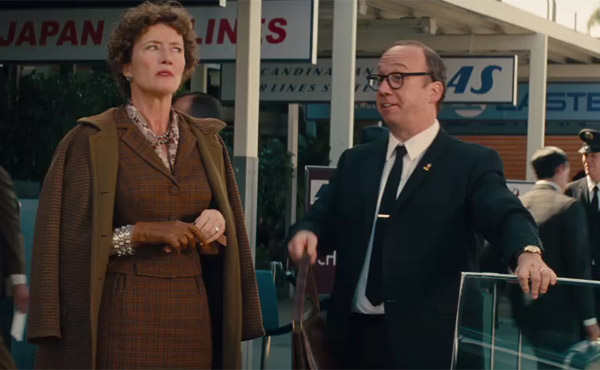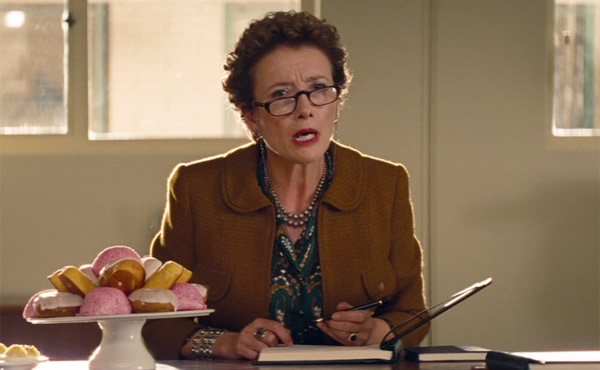I hope everyone had a very Merry Christmas yesterday. Our festivities included our annual holiday
afternoon at the movies. We took
in Saving Mr. Banks and really liked it.
I’m sure it will be nominated for many awards in the coming season of
motion picture accolades.
A quick synopsis: the year is 1961 and P. L. Travers (portrayed by Emma Thompson),
the author of the Mary Poppins stories, is summoned to Hollywood.
Walt Disney (played by Tom Hanks) is eager to fulfill a promise he made
to his daughters to bring Mary Poppins to the screen. Travers is having none of it however; she believes Disney is a huckster of cartoonish garbage, a patronizing monster who will
destroy her beloved creation. The
film follows their battles of wits and wills, as flashbacks to Travers’ early
life in Australia reveal why she is so determined to fight for the integrity of
her imaginary nanny.
 One of the things I most appreciated in Saving Mr. Banks was
the use of clothing as a way of capturing Travers’ persona and defining her in
relation to other characters.
She’s a prickly lady, extremely protective of her work and so uncompromising in manners and propriety that she seems almost inhuman. As we come to know her, and learn her back story, we see that her quirks are really the contours of a defensive shell built out of childhood traumas. This is a movie where the audience knows the ultimate ending; really, who hasn't seen Disney's Mary Poppins about a thousand times? The real suspense, and the beauty of the movie, is the journey of the central character and the things we learn as we travel with her.
One of the things I most appreciated in Saving Mr. Banks was
the use of clothing as a way of capturing Travers’ persona and defining her in
relation to other characters.
She’s a prickly lady, extremely protective of her work and so uncompromising in manners and propriety that she seems almost inhuman. As we come to know her, and learn her back story, we see that her quirks are really the contours of a defensive shell built out of childhood traumas. This is a movie where the audience knows the ultimate ending; really, who hasn't seen Disney's Mary Poppins about a thousand times? The real suspense, and the beauty of the movie, is the journey of the central character and the things we learn as we travel with her. Emma Thompson is a brilliant actress who could have brought Travelers to
life and taken her from an unlikeable curmudgeon to a sympathetic heroine even if clad in a paper bag, but she's ably assisted by costume
designer Daniel Orlandi, who sends messages in her attire.
As Travers, Thompson wears beautifully cut and fitted but extremely
formal wool suits in dark colors. Even
her jewelry is dull and sad. She
dons gloves and coats, which she certainly doesn’t need in sunny Los Angeles.
Travers sticks out like a sore thumb in California, where the Bevelry Hills
Hotel seems to be crawling with starlettes in fancy cocktail numbers and even
Disney’s secretaries blossom like animated flowers in bright blue and
yellow dresses with happy bows.
Travers’ wardrobe emphasizes her difference, as a prim English lady
(who dismisses Los Angeles as smelling like chlorine and sweat) and as a very
wounded individual who wears both her pride and her fashion like armor. One of her distinctive bracelets gives
the impression of a gauntlet---or is it a shackle?
Emma Thompson is a brilliant actress who could have brought Travelers to
life and taken her from an unlikeable curmudgeon to a sympathetic heroine even if clad in a paper bag, but she's ably assisted by costume
designer Daniel Orlandi, who sends messages in her attire.
As Travers, Thompson wears beautifully cut and fitted but extremely
formal wool suits in dark colors. Even
her jewelry is dull and sad. She
dons gloves and coats, which she certainly doesn’t need in sunny Los Angeles.
Travers sticks out like a sore thumb in California, where the Bevelry Hills
Hotel seems to be crawling with starlettes in fancy cocktail numbers and even
Disney’s secretaries blossom like animated flowers in bright blue and
yellow dresses with happy bows.
Travers’ wardrobe emphasizes her difference, as a prim English lady
(who dismisses Los Angeles as smelling like chlorine and sweat) and as a very
wounded individual who wears both her pride and her fashion like armor. One of her distinctive bracelets gives
the impression of a gauntlet---or is it a shackle? As the story moves along, some very subtle changes occur in Travers’ clothing. It’s not a spectacular adjustment, but
slowly her personal style begins to hint at comfort (with Disney and with
herself) and a growing confidence between Travers and the Californians who find
her both fascinating and infuriating.
Even her feet tell part of the story, from hiding in merciless
pumps to being flung up on a desk with merry abandonment. Near the end,
there’s a transformation in Travers' style that made me think of another Disney heroine
entirely: not Mary Poppins, but Cinderella.
As the story moves along, some very subtle changes occur in Travers’ clothing. It’s not a spectacular adjustment, but
slowly her personal style begins to hint at comfort (with Disney and with
herself) and a growing confidence between Travers and the Californians who find
her both fascinating and infuriating.
Even her feet tell part of the story, from hiding in merciless
pumps to being flung up on a desk with merry abandonment. Near the end,
there’s a transformation in Travers' style that made me think of another Disney heroine
entirely: not Mary Poppins, but Cinderella.
No comments:
Post a Comment